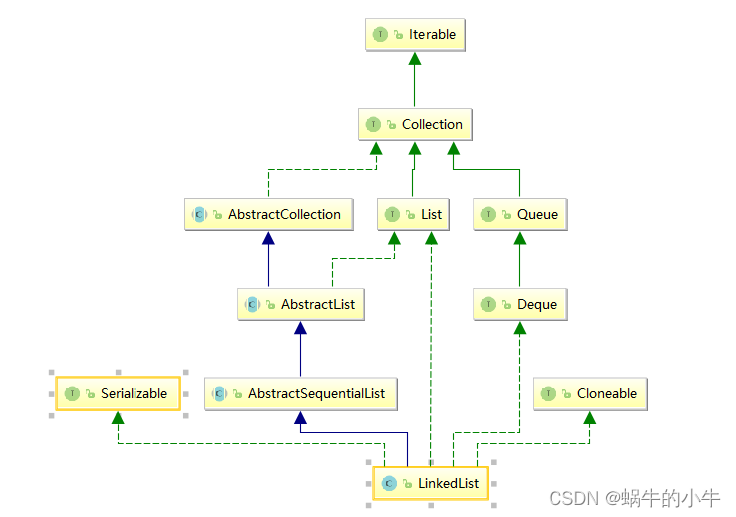文章目录
1.类继承体系

LinkedList是双向链表数据结构,它又实现了队列接口,所以又有队列的特性。
2.长度
链表不像数组那样有初始长度,除了头尾节点,每个节点都有对应的前后两个节点,只要内存够,理论上可以无限长。
3.重要方法
3.1 add(E e)
public boolean add(E e) {
// 插入尾部
linkLast(e);
return true;
}
void linkLast(E e) {
// 链表尾部last
final Node<E> l = last;
// 构造新的Node,它前节点就是插入之前的last,它后节点指向null
final Node<E> newNode = new Node<>(l, e, null);
// 新插入的节点变为尾节点
last = newNode;
if (l == null)
// 链表本身为空情况,即当前为第一个插入
first = newNode;
else
// 链表不为空,将原尾节点的下一节点指向 新插入的节点
l.next = newNode;
size++;
modCount++;
}
以下为add(itemB) 前后对比图:

3.2 get(int index)
public E get(int index) {
// 经验传入下标是否越界
checkElementIndex(index);
return node(index).item;
}
Node<E> node(int index) {
// 这里二分查找的思想
if (index < (size >> 1)) {
// 查找的下标在链表的前半段
// 从前往后找,一直到index位置返回
Node<E> x = first;
for (int i = 0; i < index; i++)
x = x.next;
return x;
} else {
// 查找的下标在链表的后半段
Node<E> x = last;
for (int i = size - 1; i > index; i--)
// 从后往前找
x = x.prev;
return x;
}
}
3.3 add(int index, E element)
public void add(int index, E element) {
checkPositionIndex(index);
if (index == size)
// 如果是插入到最后一个节点之后,上面已经介绍过linkLast
linkLast(element);
else
// 非插入到最尾的情况
linkBefore(element, node(index));
}
void linkBefore(E e, Node<E> succ) {
// succ 是下标为index的节点
// 并找出它的前节点 pred
final Node<E> pred = succ.prev;
// 生成新插入的节点e,将其前节点置为pred, 后节点置为succ
final Node<E> newNode = new Node<>(pred, e, succ);
// 原index所在节点的前节点赋值为 新插入的节点e
succ.prev = newNode;
if (pred == null)
// 如果原index前节点为空,说明原来index的节点就是first节点
// 直接将新插入的节点设置为first 节点
first = newNode;
else
// 存在前节点,则将pred的next节点指向新插入的节点
pred.next = newNode;
size++;
modCount++;
}
3.4 remove(int index)
*/
public E remove(int index) {
// 检查是否越界
checkElementIndex(index);
// 先找出下标为index的节点
return unlink(node(index));
}
E unlink(Node<E> x) {
final E element = x.item;
// 下标index的后节点
final Node<E> next = x.next;
// 下标index的前节点
final Node<E> prev = x.prev;
if (prev == null) {
// 如果前节点为null,则将first设置为next
first = next;
} else {
// 将其(被移除节点)前节点的next指向其(被移除节点)的next
prev.next = next;
// 将被移除节点的前置 设置为null,为了垃圾回收吧,反正也没有引用了
x.prev = null;
}
if (next == null) {
// 表示移除的是链表最后一个节点,那么last设置为 prev(即被移除节点的前节点)
last = prev;
} else {
// 将其(被移除)next节点的前置节点设置为prev
next.prev = prev;
// 被移除节点的next设置为null,帮助gc
x.next = null;
}
x.item = null;
size--;
modCount++;
return element;
}
3.5 indexOf(Object o)
public int indexOf(Object o) {
int index = 0;
if (o == null) {
for (Node<E> x = first; x != null; x = x.next) {
// 从头到尾遍历链表,判断是否为null,返回下标index
if (x.item == null)
return index;
index++;
}
} else {
for (Node<E> x = first; x != null; x = x.next) {
// 从头到尾遍历链表,判断是否相等,返回下标index
if (o.equals(x.item))
return index;
index++;
}
}
return -1;
}
3.6 lastIndexOf(Object o)
public int lastIndexOf(Object o) {
int index = size;
if (o == null) {
// 跟indexOf区别在于从尾部开始找
for (Node<E> x = last; x != null; x = x.prev) {
index--;
if (x.item == null)
return index;
}
} else {
for (Node<E> x = last; x != null; x = x.prev) {
index--;
if (o.equals(x.item))
return index;
}
}
return -1;
}
4. 与ArrayList性能比较
ArrayList基于动态数组来实现,LinkedList基于链表的数据结构实现,因为两者的数据结构特性,区别如下:
如果是往首部插入,LinkedList明显优于ArrayList,因为只需修改插入元素前后节点的prev值和next值即可。ArrayList因为数组复制和移动位置耗时相对较长。
如果是往尾部插入,LinkedList明显优于ArrayList,因为只需修改插入元素前后节点的prev值和next值即可。ArrayList因为数组复制和移动位置耗时相对较长。
移除元素:如果移除首尾节点,LinkedList效率高,如果按下标index移除,则ArrayList效率高于LinkedList,因为链表需要通过二分查找找到Node,再去遍历找出来移除。
数据量大时,ArrayList查找效率高于链表LinkedList.